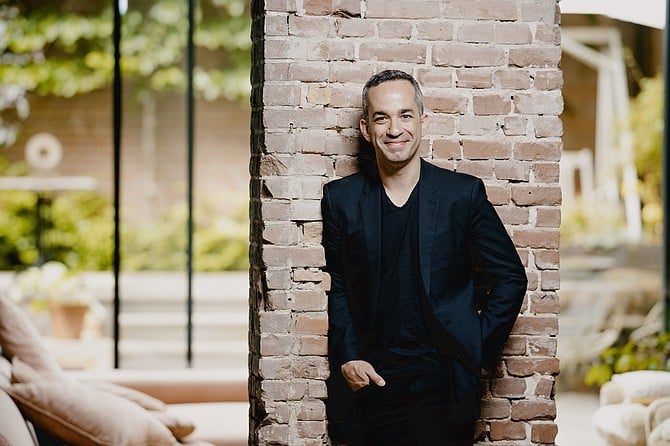 Facebook
Facebook
 X
X
 Instagram
Instagram
 TikTok
TikTok
 Youtube
Youtube

Rigorous is a word that rarely raises its strict head in the fair city of San Diego. Relaxation is the dominant paradigm. Rigor must hide in the shadows cast by the eternal sunny disposition of this most chill of cities. Yet, whenever the San Diego Symphony performs Johannes Brahms, there is no chill. The rigor of Northern Germany, Hamburg to be precise, blows strong and hard with an unrelenting blast of thoroughness, extreme accuracy, and exhaustive strictness. No composer toiled more over the correctness of the music being composed than Brahms.
On Saturday, May 20, at The Rady Shell at Jacobs Park, the San Diego Symphony gave a spectacular performance of Brahms’ Piano Concerto No. 2 with the splendid Inon Barnatan as the soloist. Barnatan has also been the music director of the La Jolla Music Society’s SummerFest since 2019. However, it is as an international superstar pianist that Barnatan is best known.
For me, the Brahms piano concertos don’t often come to mind when I consider piano concertos. I am much too distracted by the slick offerings of Rachmaninoff and Tchaikovsky. I get mesmerized by the perfect balance of Mozart. Beethoven’s Fourth and Fifth, especially the second movement of the Fourth, give me existential comfort. Yet, Brahms, and his aforementioned rigor, always astounds me when I am confronted by one of his two piano concertos.
The performance was nearly flawless. Rafael Payare appears to be as rigorous as Brahms is when it comes to conducting Brahms. Inon Baranatan was very much the same. Rigor. I believe we need as much of it as we can get.
There was a new composition after intermission. It was a standard piece of modern music complete with the obligatory rising slide into nothingness for the violins. The piece was done no favors being sandwiched between Brahms and Anton Dvorak’s Symphony No. 7.
Near the end of his life, Brahms considered Dvorak to be the greatest hope for the future of classical music and the Seventh Symphony is an excellent example of why. The structure and development of Dvorak’s unlimited supply of melody was on full display. The full impact of Dvorak’s EQ is delivered to us by the unrelenting structure that his IQ develops from start to finish.
The orchestra was in full bloom. Payare has trimmed and watered and nurtured this orchestra into the full flower of its potential–at least its potential at The Shell. When the renovated Jacobs Music Center opens this fall, stand by for an orchestral experience that has never been accomplished in San Diego, at least in my limited experience. I got a taste at the concerts in Escondido over the winter. I was very much whispering, “I want some more,” just like a young Kristen Dunst in Interview with the Vampire.


Rigorous is a word that rarely raises its strict head in the fair city of San Diego. Relaxation is the dominant paradigm. Rigor must hide in the shadows cast by the eternal sunny disposition of this most chill of cities. Yet, whenever the San Diego Symphony performs Johannes Brahms, there is no chill. The rigor of Northern Germany, Hamburg to be precise, blows strong and hard with an unrelenting blast of thoroughness, extreme accuracy, and exhaustive strictness. No composer toiled more over the correctness of the music being composed than Brahms.
On Saturday, May 20, at The Rady Shell at Jacobs Park, the San Diego Symphony gave a spectacular performance of Brahms’ Piano Concerto No. 2 with the splendid Inon Barnatan as the soloist. Barnatan has also been the music director of the La Jolla Music Society’s SummerFest since 2019. However, it is as an international superstar pianist that Barnatan is best known.
For me, the Brahms piano concertos don’t often come to mind when I consider piano concertos. I am much too distracted by the slick offerings of Rachmaninoff and Tchaikovsky. I get mesmerized by the perfect balance of Mozart. Beethoven’s Fourth and Fifth, especially the second movement of the Fourth, give me existential comfort. Yet, Brahms, and his aforementioned rigor, always astounds me when I am confronted by one of his two piano concertos.
The performance was nearly flawless. Rafael Payare appears to be as rigorous as Brahms is when it comes to conducting Brahms. Inon Baranatan was very much the same. Rigor. I believe we need as much of it as we can get.
There was a new composition after intermission. It was a standard piece of modern music complete with the obligatory rising slide into nothingness for the violins. The piece was done no favors being sandwiched between Brahms and Anton Dvorak’s Symphony No. 7.
Near the end of his life, Brahms considered Dvorak to be the greatest hope for the future of classical music and the Seventh Symphony is an excellent example of why. The structure and development of Dvorak’s unlimited supply of melody was on full display. The full impact of Dvorak’s EQ is delivered to us by the unrelenting structure that his IQ develops from start to finish.
The orchestra was in full bloom. Payare has trimmed and watered and nurtured this orchestra into the full flower of its potential–at least its potential at The Shell. When the renovated Jacobs Music Center opens this fall, stand by for an orchestral experience that has never been accomplished in San Diego, at least in my limited experience. I got a taste at the concerts in Escondido over the winter. I was very much whispering, “I want some more,” just like a young Kristen Dunst in Interview with the Vampire.
Comments